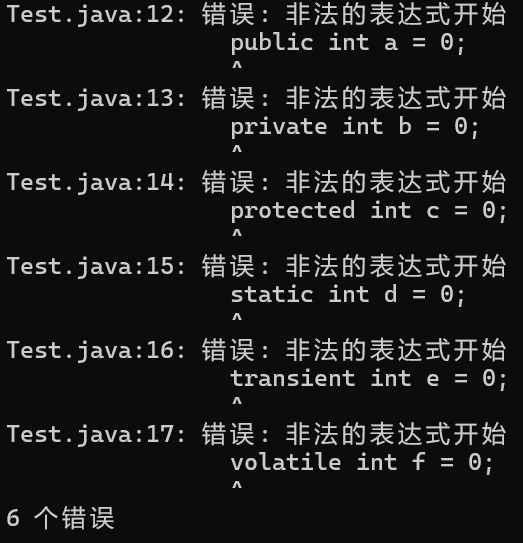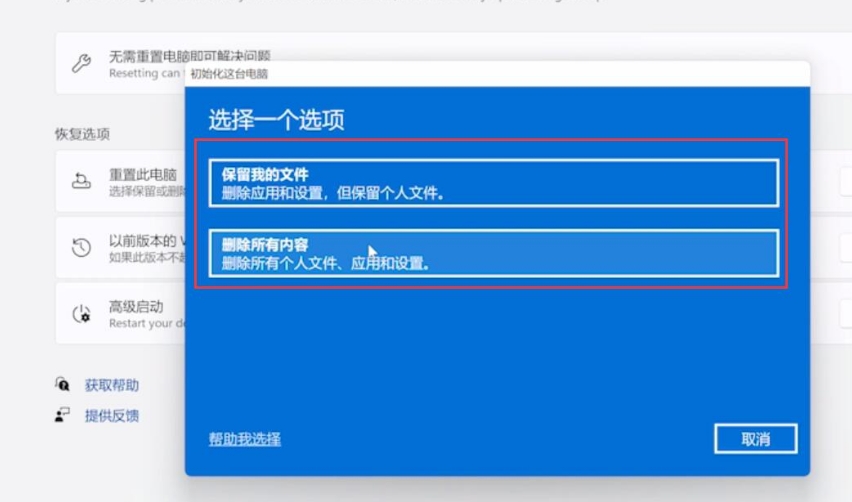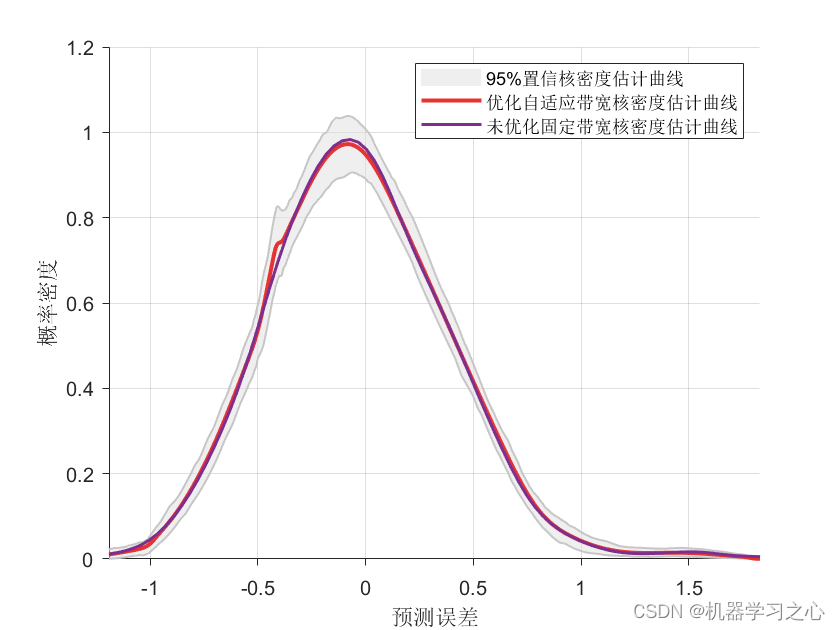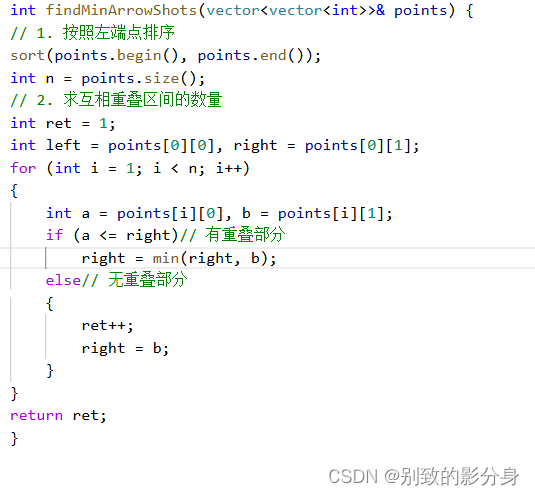知识回顾,详解引用
简单概括,引用就是给已存在对象取别名,引用变量与其引用实体共用同一块内存空间
左右值区分
 注意:不一定=左边的都是左值,=右边的都是右值
注意:不一定=左边的都是左值,=右边的都是右值
=左边的也可能是右值,等号右边的也可能是左值
int main()
{
int a = 10;
int b = 20;
// a和b都是左值,b既可以在=的左侧,也可在右侧,
// 说明:左值既可放在=的左侧,也可放在=的右侧
a = b;
b = a;
const int c = 30;
// 编译失败,c为const常量,只读不允许被修改
//c = a;
// 因为可以对c取地址,因此c严格来说不算是左值
cout << &c << endl;
// 编译失败:因为b+1返回的是一个临时变量,没有具体名称,也不能取地址,因此为右值
//b + 1 = 20;
//b+1会调用编译器自己的operator+这个函数,然后返回结果会返回一个临时对象
return 0;
}
C++11对右值进行了严格的区分:
1.C语言中的纯右值,比如:a+b, 100,a+b返回的是一个临时对象,不能对该对象取地址,所以为右值
2.将亡值。比如:表达式的中间结果、函数按照值的方式进行返回。
3.const修饰的常量,不可修改,只读类型的,理论应该按照右值对待,但因为其可以取地址(如果只是 const类型常量的定义,编译器不给其开辟空间,如果对该常量取地址时,编译器才为其开辟空间), C++11认为其是左值。
右值引用
int main()
{
//reference引用ra=reference_a
int a = 1;
int& ra1 = a;//=不表达赋值,仅表示将a变量所代表的空间重新起了一个ra的别名
//cout << &1 << endl;//错误--提示表达式必须为左值
//cout << &a << endl;//正确--区分&1,a是将1的值赋值给a,a已经开辟了空间,a为左值
//1为右值(纯右值),不能对1取地址,简单理解为。
//int& ra2 = 1;//没有地址就没有可操作空间没有空间就不能对该空间起别名
//右值引用--&&
//由于右值都没有具体空间,根据引用特性,对同一块空间取别名
//我们必须创造一个空间,并将右值传递到该空间,才能使用右值引用
int&& r1 = 1;//1赋值给一个临时空间,r1实际是对该临时空间的引用
r1 = 2;//有了空间后就能修改
cout << r1 << endl;
//int&& r2 = a;//报错--无法将右值引用绑定到左值(右值引用不能引用左值)
return 0;
}
const引用
int main()
{
int a = 1;
//const左值引用
const int& ra1 = a;
//const右值引用
const int&& ra2 = 1;
return 0;
}const可以对右值引用也可以对左值引用
右值引用作用
C++11中右值引用主要有以下作用:
1. 实现移动语义(移动构造与移动赋值)
移动构造:
string& operator=(string&& s)
{
swap(s);//对象里的变量和s(临时对象)内容交换后,将老版本内容随着s的生命周期的消失而delete
return *this//返回对象
}移动赋值:
String(String&& s)
: _str(s._str)
{
s._str = nullptr;
}2. 给中间临时变量取别名(提高效率节省资源,对于开空间的自定义类)
左右值引用后修改值
int main()
{
int a = 1;
cout << "引用前a的值" << a << endl;
//左值引用
int& ra1 = a;
ra1 = 2;
cout << "引用修改后a的值" << ra1 << endl;
//右值引用
int&& ra2 = 1;
cout << "引用前a的值" << ra2 << endl;
ra2 = 3;
cout << "引用修改后a的值" << ra2 << endl;
//这里表明:右值(1)被右值引用(ra2)后的属性是左值ra2 = 3
return 0;
}

为什么右值被右值引用后引用变量的属性是左值?
答:在被右值引用后会为右值创建一个临时变量≈创建了一个实际的存储空间。所以最后引用变量的属性是左值。
右值引用后引用变量的属性是左值
class String
{
public:
//有参构造
String(const char* str = "")
{
if (nullptr == str)
str = "";
_str = new char[strlen(str) + 1];
strcpy(_str, str);
}
//拷贝构造
String(const String& s)
: _str(new char[strlen(s._str) + 1])
{
strcpy(_str, s._str);
}
//嵌套多个函数模拟实验右值在传递后的属性
String copy(const String& s)
{
_str = new char[strlen(s._str) + 1];
strcpy(_str, s._str);
cout << "传递来的str_left_value为左值" << endl;
return *this;
}
void class_copy(String&& str_left_value)//str_left_value记为str1
{
copy(str_left_value);//str_left_value记为str2
}
//移动语义-移动构造
String(String&& s)
: _str(s._str)
{
s._str = nullptr;
}
~String()
{
if (_str) delete[] _str;
}
private:
char* _str;
};
int main()
{
String str;
str.class_copy("abc");
return 0;
}图解:
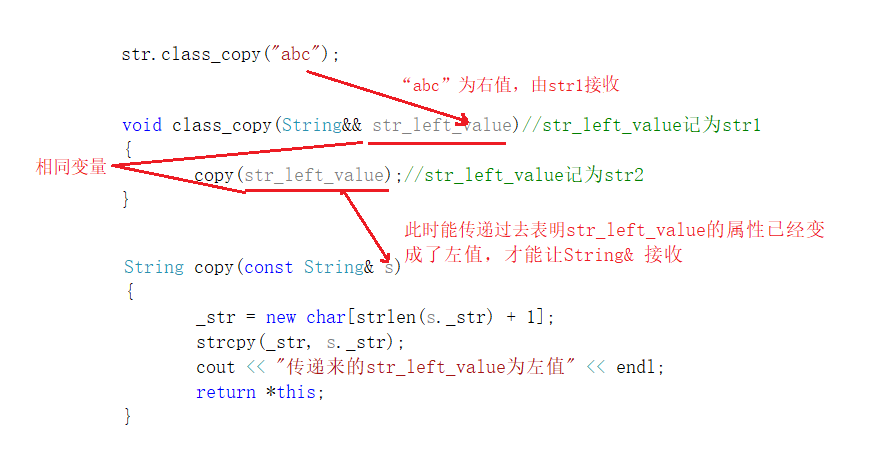
因为此时还是对数组类型进行操作,不断的复制已有内容会造成资源的浪费,我们依旧还想用右值引用来减少浪费
class String
{
public:
//有参构造
String(const char* str = "")
{
if (nullptr == str)
str = "";
_str = new char[strlen(str) + 1];
strcpy(_str, str);
}
//拷贝构造
String(const String& s)
: _str(new char[strlen(s._str) + 1])
{
strcpy(_str, s._str);
}
//仅测试
void copy(String& s)
{
cout << "传递来的str_left_value为左值" << endl;
}
void copy(String&& s)
{
cout << "传递来的str_left_value为右值" << endl;
}
//右值引用后继续使用右值
void class_copy(String&& str_left_value)
{
copy(move(str_left_value));
}
//移动语义-移动构造
String(String&& s)
: _str(s._str)
{
s._str = nullptr;
}
~String()
{
if (_str) delete[] _str;
}
private:
char* _str;
};
int main()
{
String str;
str.class_copy("abc");
return 0;
}此时只要我们将右值引用后引用变量的属性是左值让其move后转变成右值就可以继续使用右值引用
注意:为了避免const修饰右值引用导致资源无法转移,在以后使用右值引用转移资源时应避免或禁止使用const


